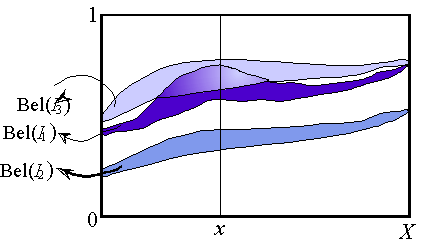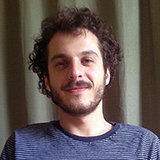Uncertainty and generalized information theory
From the theoretical foundations of computational intelligence in cognitive science and artificial life, a key problem is how information, symbols, representations and the like can arise from a purely dynamical system of many components. Similarly, the study of how information and technology enable collective intelligence, including the collective organization of societies, is of theoretical importance for computational social science. We have contributed to the study of such problems with both theoretical and applied projects. On the theoretical side, we have developed the concepts of selected self-organization, biosemiotics, and material representations. On the applied front, we are interested in using design principles from nature, particularly from biological systems dealing with information and memory, to improve information technology and to study collective intelligence. Additionally, we have used statistical prediction [Kolchinsky and Rocha, 2011] and developed information theoretical methods to study multi-scale modularity and inference in the dynamics of complex brain and biological networks [Kolchinsky et al 2014; Kolchinsky, Gates and Rocha, 2015; Correia, Navarro-Costa and Rocha, 2020; Correia et al, 2022; Parmer, Rocha, & Radicchi, 2022].
We have also worked on mathematical models of uncertainty such as Fuzzy Set Theory and the Dempster-Shafer Theory of Evidence (DST). In particular, We developed a set structure named Evidence Sets, which extended Fuzzy Sets with the DST. Evidence sets were developed to address the shortcomings of fuzzy sets as models of linguistic/cognitive categories previously discussed by George Lakoff by providing a set structure capable of dealing better with the contextual nature of cognitive categories while preserving their prototypical effects as observed by Eleanor Rosch. To make evidence sets useful, we developed new measures of uncertainty for continuous domains, since, in their membership degrees, they capture three distinct types of uncertainty: fuzziness, nonspecificity and conflict. I have also used evidence sets and their measures of uncertainty to develop soft computing agents for a digital library and web tool named TalkMine, which is capable of adapting to different user personalities and learning new terms for existing documents. More information about evidence sets is available in a separate page. The figure depicts a non-consonant evidence set.

Non-Consonant Evidence Set. The membership degree of an element in a set is defined by a set function known as a basic probability assignment. See details in [Rocha, 1999]
Project Members (Current and Former)

Luis Rocha (PI)

Alaa Abi-Haidar

Rion Brattig Correia

Alex Gates

Artemy Kolchinsky

Ana Maguitman

Olaf Sporns

Thomas Parmer
Selected Project Publications
- R.B. Correia, J.M. Almeida, Ma.J. Wyrwoll, I.Julca, D. Sobral, C.S. Misra, L.G. Guilgur, H.-C. Schuppe, N. Silva, P. Prudêncio, A. Nóvoa, A. S. Leocádio, J. Bom, M. Mallo, S. Kliesch, M. Mutwil, L.M. Rocha, F.Tüttelmann, J. D. Becker, P. Navarro-Costa [2022]. "The conserved transcriptional program of metazoan male germ cells uncovers ancient origins of human infertility". bioRxiv 2022.03.02.482557, doi: 10.1101/2022.03.02.482557.
- Parmer, T., Rocha, L.M. & Radicchi, F. [2022]. "Influence maximization in Boolean networks". Nature Communications. 13, 3457, DOI: 10.1038/s41467-022-31066-0.
- Correia, R.B., P. Navarro-Costa, and L.M. Rocha [2020]. "Extraction of overlapping modules in networks via spectral methods and information theory". Complex Networks 2020. The 9th International Workshop on Complex Networks and Their Applications. Dec. 1-3, 2020, Madrid, Spain (Online).
- A. Kolchinsky, A. Gates and L.M. Rocha. [2015] "Modularity and the spread of perturbations in complex dynamical systems." Phys. Rev. E Rapid Communications. 92, 060801(R).
- A. Kolchinsky, M. P. Van Den Heuvel, A. Griffa, P. Hagmann, L.M. Rocha, O. Sporns, J. Goni [2014]. "Multi-scale Integration and Predictability in Resting State Brain Activity". Frontiers in Neuroinformatics, 8:66. doi: 10.3389/fninf.2014.00066.
- A. Kolchinsky, and L.M. Rocha [2011].”Prediction and Modularity in Dynamical Systems“.In: Advances in Artificial Life, Proceedings of the Eleventh European Conference on the Synthesis and Simulation of Living Systems (ECAL 2011). August 8 – 12, 2011, Paris, France,. MIT Press, pp. 423-430.
- A. Abi-Haidar, J. Kaur, A. Maguitman, P. Radivojac, A. Retchsteiner, K. Verspoor, Z. Wang, and L.M. Rocha [2008]. Uncovering protein interaction in abstracts and text using a novel linear model and word proximity networks". Genome Biology. 9(Suppl 2):S11
- A. Abi-Haidar, J. Kaur, A. Maguitman, P. Radivojac, A. Retchsteiner, K. Verspoor, Z. Wang, and L.M. Rocha [2007]."Uncovering Protein-Protein Interactions in the Bibliome". Proceedings of the Second BioCreative Challenge Evaluation Workshop (ISBN 84-933255-6-2), pp.247-255.
- Rocha, L.M., T. Simas, A. Rechtsteiner, M. DiGiacomo, R. Luce [2005]. "MyLibrary@LANL: Proximity and Semi-metric Networks for a Collaborative and Recommender Web Service". In: Proc. 2005 IEEE/WIC/ACM International Conference on Web Intelligence (WI'05), IEEE Press. IEEE Press, pp. 565-571.
- Rocha, L.M. [2003]. "Automatic Conversation Driven by Uncertainty Reduction and Combination of Evidence for Recommendation Agents ". In: Systematic Organization of Information in Fuzzy Systems. NATO Science Series. P. Melo-Pinto, H.N. Teodorescu and T. Fukuda (Eds.) IOS Press, pp 249-265.
- Rocha, Luis M. [2002]. "Semi-metric Behavior in Document Networks and its Application to Recommendation Systems". In: Soft Computing Agents: A New Perspective for Dynamic Information Systems. V. Loia (Ed.) International Series Frontiers in Artificial Intelligence and Applications. IOS Press. pp. 137-163.
- Rocha, Luis M. [2002]. "Combination of Evidence in Recommendation Systems Characterized by Distance Functions". In: Proceedings of the 2002 World Congress on Computational Intelligence: FUZZ-IEEE'02. Honolulu, Hawaii, May 2002. IEEE Press, pp. 203-208. LAUR 02-154.
- Rocha, Luis M. [2001]. "TalkMine: a Soft Computing Approach to Adaptive Knowledge Recommendation". In: Soft Computing Agents: New Trends for Designing Autonomous Systems. Vincenzo Loia and Salvatore Sessa (Eds.). Series on Studies in Fuzziness and Soft Computing. Physica-Verlag, Springer, pp. 89-116
- Rocha, Luis M. [2001]. "Adaptive Recommendation and Open-Ended Semiosis". Kybernetes. Vol. 30, No. 5-6.
- Rocha, Luis M. [1999]." Evidence Sets: Modeling Subjective Categories." In: International Journal of General Systems. Vol. 27, pp. 457-494.
- Joslyn, Cliff and Luis Rocha [1997]."Towards a Formal Taxonomy of Hybrid Uncertainty Representations" . Information Sciences. 110(3–4):255-277.
- Rocha, Luis M. [1997]." Relative Uncertainty and Evidence Sets: A Constructivist Framework." In: International Journal of General Systems. Vol. 26 (1-2), pp. 35-61.
- Rocha, Luis M. [1997]." Evidence Sets: Contextual Categories " In: Proceedings of the meeting on Control Mechanisms for Complex Systems, Physical Science Laboratory, New Mexico State University, Las Cruces, New Mexico, January 1997. M. Coombs (ed.). NMSU Press, pp. 339-357.
- Rocha, Luis M. [1997]." Evidence Sets and Contextual Genetic Algorithms: Exploring Uncertainty, Context, and Embodiment in Cognitive and Biological Systems. PhD Dissertation. State University of New York at Binghamton.
- Rocha, Luis M., V. Kreinovich, and R. Kearfott[1996]." Computing Uncertainty in Interval Based Sets." In: Applications of Interval Computation. R.B. Kearfott and V. Kreinovich (Eds.). Kluwer Academic Press. pp. 337-380.
- Rocha, Luis M. [1996]." Relative Uncertainty: Measuring Uncertainty in Discrete and Nondiscrete Domains. " In: Proceedings of the NAFIPS'96. Michael Smith et al (Eds.) U.C. Berkeley. IEEE Press, pp. 551-555.
- Henry, C. and Luis M. Rocha [1996]." Language Theory: Consensual Selection of Dynamics ." In: Cybernetics and Systems: An International Journal. Vol. 27, pp. 541-553.
- Rocha, Luis M. [1995]." Interval Based Evidence Sets ." In: Proceedings of the ISUMA-NAFIPS'95. B. Ayyub (Ed.). IEEE Press. pp.624-629.
- Rocha, Luis M. [1994]." Cognitive Categorization revisited: extending interval valued fuzzy sets as simulation tools for concept combination ." In: Proceedings of the 1994 International Conference of NAFIPS/IFIS/NASA. IEEE Press. pp 400-404.
- Rocha, Luis M. [1991]." Fuzzification of Conversation Theory (pdf). In: Principia Cybernetica Conference, Free University of Brussels, Brussels, June 1991. Ed. Francis Heylighen.